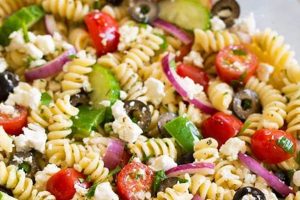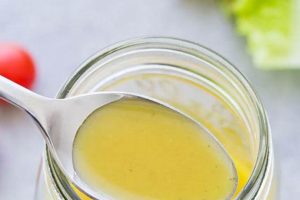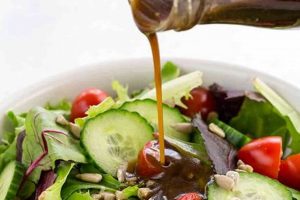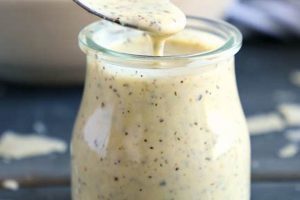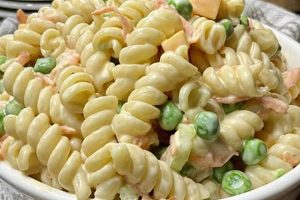A guide to preparing a smooth, emulsified dressing featuring the characteristic flavors of Italian cuisine typically involves a combination of oil, an acidic element such as vinegar or lemon juice, and seasonings like garlic, oregano, and sometimes Parmesan cheese. Variations can include the addition of mayonnaise, sour cream, or buttermilk for added creaminess.
Mastering this type of dressing elevates simple salads from basic to flavorful and satisfying. A well-executed emulsion provides a rich mouthfeel and distributes the flavors evenly across the salad ingredients. It represents a versatile culinary asset, adaptable to various greens, vegetables, and even proteins. Historically, emulsions like this were essential for preserving and enhancing the flavor of fresh ingredients before refrigeration was readily available. Today, they remain a staple in kitchens worldwide for their flavor and ease of preparation.
The following sections will delve into specific ingredients, explore various preparation methods, and offer tips for achieving optimal flavor and texture. From classic recipes to contemporary adaptations, this guide provides a comprehensive resource for creating the perfect accompaniment to any salad.
Tips for Creamy Italian Salad Dressing
Achieving a perfectly emulsified and flavorful dressing requires attention to detail. These tips offer guidance for optimal results.
Tip 1: Use High-Quality Ingredients. The flavor of the dressing relies heavily on the quality of its components. Opt for extra virgin olive oil, fresh garlic, and flavorful herbs.
Tip 2: Balance Acidity. The balance between oil and acid is crucial. Taste and adjust the ratio of vinegar or lemon juice to achieve a pleasant tang without excessive sharpness.
Tip 3: Emulsify Thoroughly. Proper emulsification creates a smooth, creamy texture. Whisk ingredients vigorously or use a blender to combine them completely. A slow, steady drizzle of oil into the other ingredients while whisking helps create a stable emulsion.
Tip 4: Seasoning is Key. Freshly ground black pepper, salt, and a pinch of sugar can elevate the overall flavor profile. Experiment with additional herbs like oregano or basil.
Tip 5: Fresh Garlic for Best Flavor. While garlic powder can be used in a pinch, fresh garlic offers a more pungent and complex flavor.
Tip 6: Consider Adding Dairy. A dollop of mayonnaise, sour cream, or buttermilk can contribute to a richer, creamier consistency.
Tip 7: Taste and Adjust. Palates vary, so taste the dressing and adjust seasonings as needed to achieve the desired balance of flavors.
Tip 8: Proper Storage. Store leftover dressing in an airtight container in the refrigerator for up to a week. Allow it to come to room temperature before serving to enhance the flavors.
By following these guidelines, one can consistently create a flavorful and well-balanced dressing that complements a variety of salads and dishes.
With these tips in mind, the following section will explore several variations on the classic recipe, demonstrating the versatility of this culinary staple.
1. Emulsification
Emulsification is fundamental to achieving the desired texture and stability in a creamy Italian salad dressing. It is the process of combining two immiscible liquids, typically oil and an acid like vinegar or lemon juice, into a stable mixture. In the context of this dressing, emulsification prevents the oil and vinegar from separating, resulting in a smooth, creamy consistency rather than a layered or broken mixture. This process is crucial for evenly distributing flavors and providing a pleasant mouthfeel. Without proper emulsification, the dressing’s flavor profile suffers, with oil and vinegar notes experienced separately instead of melding together harmoniously. Vigorous whisking or the use of a blender provides the mechanical force necessary to disperse tiny droplets of one liquid within the other, creating the emulsion. Adding emulsifying agents like mustard or egg yolk can further stabilize the mixture, promoting long-term homogeneity.
A real-world example illustrates this concept clearly: imagine drizzling plain oil and vinegar over a salad. The oil will pool on the surface, while the vinegar will sink to the bottom, coating the leaves unevenly. The flavors remain isolated, failing to complement each other or the salad ingredients. However, a properly emulsified creamy Italian dressing clings evenly to the salad components, delivering a balanced flavor with every bite. This underscores the practical significance of emulsification. It directly impacts the sensory experience of the dressing, enhancing both its taste and texture. The resulting stability also allows for consistent quality, even after storage.
In summary, emulsification is not merely a technical culinary term; it is the essential process responsible for the very essence of a successful creamy Italian salad dressing. Understanding this concept allows for greater control over the final product, enabling consistent production of a smooth, flavorful, and stable dressing. Challenges such as over-acidification or insufficient mixing can be overcome with this knowledge, paving the way for culinary excellence in the seemingly simple art of salad dressing preparation.
2. High-quality Oil
High-quality oil plays a crucial role in the overall success of a creamy Italian salad dressing. The oil contributes significantly to the dressing’s flavor, texture, and mouthfeel. Opting for high-quality extra virgin olive oil, for instance, introduces a distinct fruity and peppery flavor profile that complements the other ingredients. Lower quality oils can impart undesirable flavors, detracting from the intended taste. Furthermore, the oil’s viscosity directly influences the emulsion’s stability and the dressing’s final texture. A high-quality oil emulsifies more readily and maintains a stable, creamy consistency, preventing separation and ensuring a pleasant sensory experience. Consider the difference between using a robust extra virgin olive oil versus a generic vegetable oil. The extra virgin olive oil provides depth and complexity, while the generic oil might result in a bland or even slightly bitter dressing. This difference highlights the impact of oil quality on the final product.
The practical significance of using high-quality oil extends beyond immediate flavor. It contributes to the overall nutritional value of the dressing, offering beneficial fatty acids and antioxidants. Moreover, a superior oil enhances the perceived value of the dish, transforming a simple salad into a more sophisticated culinary experience. In a restaurant setting, for example, the use of high-quality oil can elevate the perceived quality of the meal, justifying a higher price point. Conversely, using subpar oil can negatively impact customer perception, even if other ingredients are of high quality. This illustrates the far-reaching implications of oil selection.
In summary, the choice of oil in a creamy Italian salad dressing is not a trivial matter. It directly impacts flavor, texture, nutritional value, and even perceived value. Prioritizing high-quality oil ensures a superior culinary outcome, enhancing both the sensory experience and the overall quality of the dish. Challenges such as cost considerations can be mitigated by carefully balancing quality with budget constraints, exploring different oil varieties, and focusing on sourcing reputable brands. Understanding the significance of this seemingly simple ingredient allows for a more informed approach to crafting a truly exceptional creamy Italian dressing.
3. Fresh Herbs
Fresh herbs constitute a defining characteristic of creamy Italian salad dressing, contributing significantly to its aromatic complexity and vibrant flavor profile. The inclusion of herbs such as oregano, basil, parsley, and chives elevates the dressing beyond a simple emulsion of oil and acid, imparting a distinctive herbal freshness that complements the richness of the other ingredients. This characteristic freshness derives from the volatile aromatic compounds present in fresh herbs, compounds often diminished or lost during the drying process. A direct comparison between dressings made with fresh versus dried herbs reveals a notable disparity in flavor intensity and overall complexity. For instance, fresh basil provides a sweet, slightly peppery anise note that dried basil often fails to replicate fully. This difference underscores the crucial role of fresh herbs in achieving an authentic and flavorful outcome.
The practical implications of using fresh herbs extend beyond flavor enhancement. Fresh herbs contribute visual appeal, adding vibrant green hues and textural variation to the dressing. This visual element enhances the overall dining experience, stimulating appetite and adding a touch of elegance to even the simplest of salads. Moreover, fresh herbs offer potential health benefits, providing antioxidants and other bioactive compounds. While the quantities of herbs in a salad dressing may not provide substantial nutritional impact, their inclusion contributes to a more wholesome and flavorful culinary experience. Consider the difference between a commercially produced dressing containing dried herbs and a homemade version featuring freshly chopped basil and oregano. The fresh herbs immediately elevate the perceived quality and freshness of the homemade dressing, transforming it into a more vibrant and appealing condiment.
In conclusion, the utilization of fresh herbs in creamy Italian salad dressing is a critical factor in achieving optimal flavor, aroma, and visual appeal. While dried herbs offer convenience, they cannot fully replicate the vibrancy and complexity of their fresh counterparts. Embracing the use of fresh herbs allows for a more nuanced and flavorful dressing, enhancing the overall culinary experience. Challenges such as herb availability and perishability can be addressed through proper storage techniques, freezing excess herbs for later use, or exploring readily available alternatives in different seasons. Recognizing the vital role of fresh herbs allows for a more informed and flavorful approach to crafting a truly exceptional creamy Italian salad dressing.
4. Balanced Acidity
Balanced acidity is paramount in a creamy Italian salad dressing, acting as a critical counterpoint to the richness of the oil and the sweetness of any additional ingredients. It provides a bright, refreshing element that prevents the dressing from becoming overly heavy or cloying. The correct acidity level elevates and harmonizes the other flavors, creating a more complex and palatable final product.
- Flavor Enhancement
Acidity brightens the overall flavor profile, cutting through the richness of the oil and enhancing the savory notes of herbs and spices. Imagine tasting a dressing made solely of oil and herbs; it would likely feel heavy and lack vibrancy. The introduction of an acidic element, like vinegar or lemon juice, immediately awakens the palate, making the other flavors more pronounced and enjoyable. This transformative effect underscores the importance of acidity in creating a balanced and flavorful dressing.
- Emulsion Stability
Acidity plays a crucial role in emulsion stability. The acidic component interacts with the oil and other ingredients, contributing to a more stable and homogenous mixture. This stability prevents the dressing from separating into its constituent parts, ensuring a consistently smooth and creamy texture. Without sufficient acidity, the emulsion is more likely to break, resulting in a less appealing and potentially oily dressing. This highlights the practical significance of balanced acidity in maintaining the desired texture and consistency.
- Preservation
Historically, acidic ingredients like vinegar served as natural preservatives, inhibiting bacterial growth and extending the shelf life of food. While modern refrigeration minimizes this need, the acidic element in a creamy Italian dressing still contributes to its overall stability and longevity. This inherent preservative quality allows for safe storage and consumption of the dressing over several days, minimizing waste and ensuring consistent quality. This practical benefit further underscores the multifaceted role of acidity in the recipe.
- Ingredient Compatibility
Balanced acidity ensures compatibility with a wide range of salad ingredients. The bright, tangy notes of the dressing complement various greens, vegetables, and even proteins, enhancing their natural flavors without overpowering them. A highly acidic dressing might clash with delicate greens, while a dressing lacking acidity might fail to complement heartier vegetables. This adaptability demonstrates the importance of balanced acidity in creating a versatile and universally appealing dressing.
In conclusion, balanced acidity is not merely an optional component but a fundamental element in crafting a successful creamy Italian salad dressing. Its role extends beyond simple flavor enhancement; it contributes to emulsion stability, preservation, and ingredient compatibility. Achieving this balance requires careful consideration of the type and quantity of acidic ingredients used, taking into account the other components of the recipe and the desired flavor profile. A well-balanced acidity ultimately elevates the dressing from a simple condiment to a crucial component of a delicious and satisfying salad.
5. Proper Seasoning
Proper seasoning is the cornerstone of a successful creamy Italian salad dressing, elevating it from a simple mixture of ingredients to a harmonious blend of flavors. It provides depth, complexity, and balance, transforming the individual components into a cohesive and palatable whole. Without proper seasoning, the dressing, regardless of the quality of its ingredients, remains underdeveloped and lacks the vibrancy that distinguishes a truly exceptional culinary creation.
- Salt’s Foundational Role
Salt acts as the foundation of proper seasoning, enhancing the inherent flavors of the other ingredients. It amplifies the sweetness of vegetables, the tanginess of the vinegar, and the richness of the oil. It does not merely add a salty taste but rather unlocks and intensifies the existing flavor profile. Imagine tasting a tomato without salt; it might taste bland or even slightly acidic. A sprinkle of salt, however, brings out the tomato’s natural sweetness and complexity. This same principle applies to salad dressings. Salt acts as a flavor enhancer, ensuring that all the components contribute fully to the overall taste experience.
- Black Pepper’s Complexity
Black pepper introduces a layer of complexity, providing a subtle heat and a nuanced spice that complements the other flavors. Freshly ground black pepper offers a more robust and aromatic experience compared to pre-ground pepper, releasing volatile oils that contribute to the dressing’s overall aroma and taste. The subtle bite of black pepper balances the richness of the oil and the acidity of the vinegar, preventing the dressing from becoming overly sweet or cloying. It adds a depth of flavor that enhances the overall sensory experience.
- Balancing Sweetness and Acidity
A touch of sweetness, often in the form of a pinch of sugar or a drizzle of honey, can balance the acidity and enhance the overall flavor profile. This subtle sweetness rounds out the sharpness of the vinegar, creating a more harmonious and balanced taste. It also complements the herbal notes, particularly if using sweeter herbs like basil. This balancing act is crucial in achieving a dressing that is neither too tart nor too sweet, but rather a nuanced blend of complementary flavors.
- Herbs and Aromatics
In addition to salt, pepper, and a touch of sweetness, proper seasoning may involve incorporating additional herbs and aromatics like garlic powder, onion powder, or red pepper flakes. These additions further enhance the complexity of the dressing, introducing subtle nuances that elevate the overall flavor profile. The choice of herbs and aromatics can be tailored to complement specific salad ingredients or to create unique flavor combinations. For example, a hint of garlic powder adds a savory depth, while red pepper flakes introduce a touch of heat.
The interplay of these seasoning elements is crucial in achieving a well-balanced and flavorful creamy Italian salad dressing. The proper balance of salt, pepper, sweetness, and additional aromatics transforms the individual ingredients into a unified and harmonious whole. This meticulous attention to seasoning distinguishes an exceptional dressing from a mediocre one, elevating a simple salad into a culinary delight. It allows for the creation of a dressing that not only complements the salad ingredients but also stands on its own as a flavorful and complex condiment.
6. Ingredient Ratios
Ingredient ratios are fundamental to the success of a creamy Italian salad dressing recipe, dictating the final balance of flavors, texture, and overall quality. Precise ratios ensure consistency and predictability, allowing for replication of desired outcomes. They govern the interplay between oil, acid, and other components, impacting the emulsion’s stability, the dressing’s thickness, and the intensity of its flavor profile. Consider the ratio of oil to vinegar: a higher oil content yields a richer, creamier dressing, while a higher vinegar content results in a sharper, more tart flavor. This delicate balance, determined by precise ratios, directly influences the sensory experience. A real-world example illustrates this concept: if a recipe calls for a 3:1 ratio of oil to vinegar and this ratio is skewed, the resulting dressing might be either excessively oily or overly acidic, disrupting the intended balance and diminishing the overall quality. Understanding these ratios empowers one to adjust a recipe to suit individual preferences or specific culinary needs, such as creating a lighter dressing for delicate greens or a more robust dressing for heartier vegetables.
The practical significance of understanding ingredient ratios extends beyond achieving a balanced flavor profile. It allows for efficient scaling of recipes, whether for a small gathering or a large event. Maintaining consistent ratios when increasing or decreasing recipe quantities ensures a predictable outcome, regardless of the serving size. Furthermore, this knowledge allows for informed substitutions and adaptations. If a particular ingredient is unavailable, understanding the underlying ratios allows for calculated substitutions without compromising the dressing’s fundamental characteristics. For instance, lemon juice can often be substituted for vinegar while maintaining the desired acidity level if the appropriate ratio is applied. This adaptability is crucial for both home cooks and professional chefs, enabling creativity and flexibility in the kitchen.
In conclusion, ingredient ratios are not mere numerical suggestions but rather essential components of a successful creamy Italian salad dressing recipe. They dictate the final product’s flavor, texture, and stability. Mastering these ratios allows for consistent results, scalability, and adaptability, empowering both novice and experienced cooks to create a perfectly balanced and flavorful dressing every time. Challenges such as imprecise measurements or ingredient substitutions can be addressed through careful attention to ratios and an understanding of their impact on the final product. This knowledge ultimately transforms the act of making salad dressing from a matter of guesswork to a precise culinary endeavor.
Frequently Asked Questions
This section addresses common inquiries regarding the preparation and utilization of creamy Italian salad dressing.
Question 1: What is the ideal ratio of oil to vinegar in a creamy Italian dressing?
A classic ratio is 3:1, but this can be adjusted to personal preference. A higher oil ratio yields a richer dressing, while a higher vinegar ratio increases tartness. Flavor profiles vary with oil and vinegar selection, so experimentation is encouraged to achieve individual desired outcomes.
Question 2: Can alternative acidic ingredients be used in place of vinegar?
Lemon juice provides a brighter, citrusy alternative. Other options include red or white wine, or even buttermilk for added creaminess. The substitution ratio will vary depending on the acidity of the chosen ingredient.
Question 3: How can a stable emulsion be achieved consistently?
Slow, steady whisking or blending while gradually drizzling the oil into the other ingredients promotes a stable emulsion. Adding a small amount of mustard or egg yolk can act as an emulsifier, further enhancing stability.
Question 4: What are effective methods for storing leftover dressing?
Store in an airtight container in the refrigerator for up to one week. Separation may occur during refrigeration; whisk vigorously before serving to re-emulsify.
Question 5: How can one adjust the dressings thickness?
Adding a small amount of mayonnaise, Greek yogurt, or pureed avocado can create a thicker, creamier consistency. Conversely, a thinner dressing can be achieved by adding a small amount of water or additional vinegar.
Question 6: What herbs and spices best complement a creamy Italian dressing?
Fresh oregano and basil are traditional choices. Other complementary options include parsley, chives, thyme, garlic powder, onion powder, or red pepper flakes for a touch of heat. Experimentation with different herb and spice combinations allows for customized flavor profiles.
Understanding these fundamental aspects contributes to consistent success in crafting delicious and versatile creamy Italian salad dressings tailored to individual preferences.
The following section will explore variations of creamy Italian dressing, adapting the classic recipe to suit diverse palates and dietary needs.
Conclusion
Exploration of the elements comprising a successful creamy Italian salad dressing recipe reveals the interplay of several key factors. Emulsification, achieved through proper technique and ingredient selection, forms the foundation of the desired texture and stability. High-quality oil contributes significantly to flavor and mouthfeel, while fresh herbs provide the characteristic aromatic notes defining this classic dressing. Balanced acidity, achieved through precise ratios of vinegar or other acidic components, plays a crucial role in both flavor and emulsion stability. Proper seasoning, including salt, pepper, and often a touch of sweetness, further enhances the overall flavor profile, creating a harmonious balance of tastes. Finally, careful attention to ingredient ratios ensures consistent results and allows for adaptability to individual preferences and dietary needs. Each element contributes not only to the immediate sensory experience but also to the overall quality and versatility of the dressing.
Mastery of these elements empowers culinary exploration and consistent achievement of a superior creamy Italian salad dressing. Understanding the underlying principles, rather than mere adherence to a fixed recipe, allows for adaptation and innovation, ensuring a consistently delightful culinary experience. This knowledge translates to enhanced flavor, improved texture, and greater control over the final product, ultimately elevating a simple salad to a more refined and satisfying dish. The pursuit of a perfect creamy Italian dressing, therefore, becomes an exercise in culinary precision and a testament to the transformative power of understanding fundamental ingredients and techniques.

